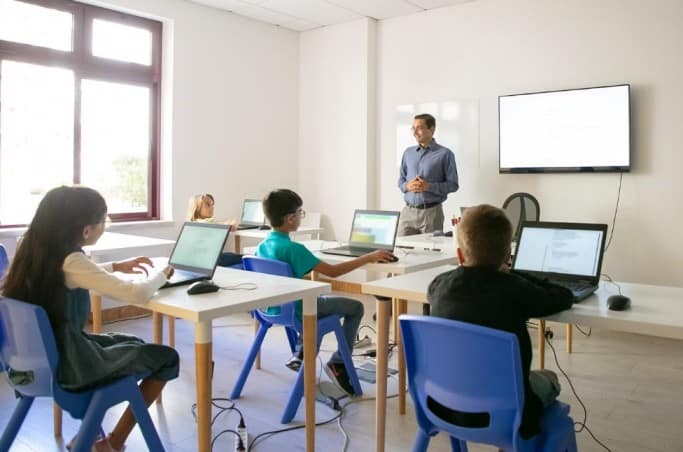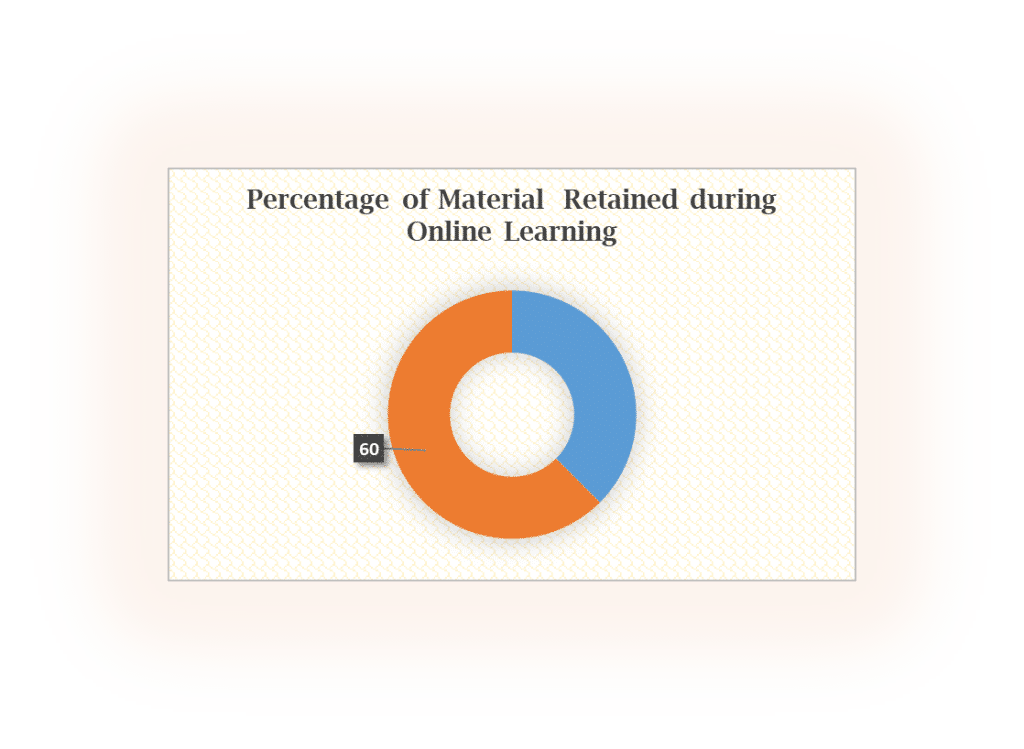
La classe inversée – Un guide complet
La classe inversée est une approche très efficace pour améliorer l'engagement et la collaboration des élèves. À l'ère de la numérisation, cette stratégie pédagogique est très bénéfique. Car elle permet aux élèves d'utiliser à la fois l'apprentissage asynchrone
La classe inversée est une approche très efficace pour améliorer l’engagement et la collaboration des élèves. À l’ère de la numérisation, cette stratégie pédagogique est très bénéfique. Elle permet aux élèves d’utiliser parfaitement la durée asynchrone et synchrone . C’est une approche idéale qui les aide à mieux comprendre même les parties les plus compliquées d’un sujet (avec l’aide de séances de résolution de problèmes). Et les élèves peuvent facilement terminer la partie la moins compliquée à la maison.
Plongeons-nous plus en profondeur et comprenons mieux cette approche.
Qu'est-ce qu'une classe inversée ?
En gros, ce modèle comprend du matériel préenregistré distribué aux élèves pour préparer une discussion collaborative. Il peut s'agir de courtes vidéos ou d'une ressource en ligne que les élèves utilisent pour acquérir une compréhension approfondie du sujet. Cette durée d'apprentissage à domicile est ensuite suivie d'une séance guidée par l'enseignant. Elle est utilisée pour dissiper les doutes et étendre les possibilités de compréhension de perspectives variées sur le même sujet.
Cette approche était également utilisée dans une salle de classe traditionnelle, mais maintenant, avec la popularité croissante de l’éducation en ligne, cette approche s’est avérée être un grand soutien aux processus d’enseignement et d’apprentissage en ligne.
Avant de discuter des avantages de ce modèle et des moyens de le mettre en œuvre, examinons quelques faits intéressants :
- Selon une étude, cette approche a montré une amélioration remarquable des résultats des élèves du collège. 73,8 % des élèves ont obtenu des résultats remarquablement bons après l’utilisation de cette approche.
- Il a été conclu que les avantages notables de cette approche sont le développement des compétences de résolution de problèmes, l’innovation, la coopération, etc.

Maintenant que nous connaissons ce modèle, passons à ses avantages pour les étudiants :
- Possibilité de collaboration
La collaboration consiste à travailler ensemble en petits groupes vers un objectif commun. Dans une classe inversée, les élèves sont des apprenants actifs et construisent leurs connaissances en collaborant avec leurs pairs. L'avantage de l'apprentissage virtuel est que les élèves acquièrent une compréhension plus approfondie du sujet. Et pour cela, ils n'ont pas besoin de se rendre dans une salle de classe physique. Et ils apprennent également à appliquer leurs connaissances grâce à des interactions significatives.
Une fois que les élèves ont reçu le contenu pédagogique, ils peuvent interagir avec leurs pairs avant d'assister à la séance avec l'enseignant. C'est une excellente façon de promouvoir des interactions significatives entre des élèves de cultures et d'horizons variés.
- Meilleure rétention des connaissances
Savez-vous que l’éducation en ligne peut améliorer la rétention d’informations par un étudiant ?
Oui!
En fait, l’apprentissage en ligne peut aider les étudiants à retenir près de 25 à 60 % de matière en plus par rapport à l’apprentissage traditionnel.
Cet avantage de l’apprentissage virtuel se traduit parfaitement par des approches comme la classe inversée. Car le contenu numérique et sa préparation (discussions, application des connaissances acquises, improvisation du contenu, etc.) motivent les étudiants à ajouter plus de valeur à leur apprentissage. Une meilleure participation des étudiants et des possibilités d’apprentissage actif les incitent à s’approprier leur apprentissage. Et naturellement, ils retiennent mieux les connaissances acquises.

- Idéal pour tous les types d'étudiants
Selon une revue de référence, la méthode de l’inversion en classe est un soutien pour tous les types d’élèves. Cela inclut ceux qui ont des difficultés scolaires. Ce modèle leur donne suffisamment de temps pour se préparer à un sujet. De plus, ils peuvent revoir le contenu encore et encore, prendre des notes, saisir les concepts à leur propre rythme. Et aussi rechercher davantage de soutien grâce à des instructions individuelles. En raison de ces avantages frappants, cette approche est considérée à juste titre comme l’avenir de l’apprentissage dans les temps à venir.
- Moins de distractions
Les classes ordinaires peuvent être source de distractions diverses pour les élèves. Mais cette approche centrée sur l'élève est une solution crédible à tous les défis auxquels les enseignants et les élèves sont confrontés dans leur vie quotidienne. Grâce à cette approche, les élèves ont la possibilité de se livrer à des interactions significatives et très productives. Ils ressentent également un sens des responsabilités qui, à son tour, renforce leur autodiscipline et leur motivation à bien performer. Contrairement aux instructions classiques (méthodes basées sur des cours magistraux) et aux méthodes banales, cette approche pédagogique est plus efficace pour renforcer le zèle de l'élève à apprendre.
Maintenant que nous en savons suffisamment sur cette approche, explorons quelques autres aspects.
Quand le flipping en classe est-il efficace ?
D'une manière générale, cette approche est très efficace pour les élèves qui peuvent interagir et participer à des discussions, effectuer des tâches en collaboration et aimer résoudre des problèmes. Bien que ce modèle convienne à la plupart des élèves, il appartient à l'enseignant de créer des groupes de manière réfléchie avec un mélange hétérogène de tous les types d'élèves. Une conception pédagogique bien planifiée peut convenir à divers types de sujets complexes qui peuvent convenir aux élèves (tels que des questions brûlantes, des problèmes ou des sommes en mathématiques, etc.)
Passons maintenant aux aspects de ce modèle pour les enseignants.
Comment mettre en œuvre l’approche de la classe inversée ?
Dans un environnement d'apprentissage en ligne, le modèle inversé en classe crée des opportunités d'apprentissage sur mesure pour les étudiants. Une recherche peut nous aider à comprendre la meilleure façon d'utiliser ce modèle dans une salle de classe.
Selon l' Open Journal for Educational Research, 2019 (Center for Open Access in Science), les enseignants peuvent mettre en œuvre ce modèle en trois étapes :
- Pré-évaluation ou pré-cours – Fournir du matériel pédagogique approprié aux étudiants afin qu’ils puissent apprendre dans leur propre espace.
- Clarification de concepts ou pendant le cours - Interactions sur les connaissances acquises, points ouverts nécessitant des clarifications et discussion sur des points de vue variés.
- Evaluation ou post-cours - Retour sur la plateforme et vérification du niveau de connaissances .

La planification systématique de ce modèle dépend de l'expertise de l'enseignant pour comprendre comment et ce que les élèves doivent apprendre. Après la phase de planification, cette conception peut être mise en œuvre. Et la preuve de la compréhension de l'élève peut être utilisée pour évaluer le niveau de réussite de la conception globale.
Réflexions finales
L’avenir de l’apprentissage à l’ère numérique dépend fortement de nos modèles de prestation et de notre capacité à répondre aux besoins d’apprentissage uniques des étudiants. La bonne nouvelle est que les écoles en ligne et les plateformes d’apprentissage numérique ont déjà révolutionné le monde de l’éducation grâce à un contenu en ligne de haute qualité. Des approches telles que l’inversion des classes peuvent éliminer de nombreux obstacles à l’apprentissage (comme les distractions dans une salle de classe bruyante et la pression scolaire, etc.). En fait, elles peuvent atteindre tous les types d’étudiants, les rendant plus actifs, heureux, engagés et motivés à apprendre. Le meilleur dans cette approche est qu’elle constitue une merveilleuse façon de développer un « AMOUR POUR L’APPRENTISSAGE ». Et il va sans dire que les étudiants chériront cet avantage inégalé tout au long de leur vie !
Questions fréquemment posées
- Qu'est-ce qu'une classe inversée ?
Une classe inversée permet aux étudiants de participer activement à leur processus d'apprentissage en ligne. Les enseignants choisissent un contenu/une ressource pédagogique, les étudiants étudient et se préparent pour une session synchrone. Une évaluation post-session est utilisée pour évaluer l'efficacité de l'approche.
- Quels sont les avantages de l’inversion en classe ?
Parmi les avantages, on peut citer une meilleure rétention de l’information grâce à une plus grande implication des élèves. Cette approche favorise également la collaboration des élèves par le biais d’interactions formelles et informelles.
- Le retournement en classe est-il bénéfique pour les élèves à risque ou en retard scolaire ?
Cette approche permet aux élèves d'apprendre par l'intermédiaire de leurs pairs en dehors des structures classiques d'une salle de classe ordinaire. Tous les types d'élèves se sentent plus à l'aise et acquièrent plus de connaissances grâce à ce modèle.
Lectures suggérées :
- Comment soutenir émotionnellement vos enfants
- 5 stratégies pour développer un état d’esprit de croissance chez votre enfant
- Stratégies de pensée positive pour les adolescents
- Promouvoir l'autorégulation chez les adolescents et les enfants
- Problèmes scolaires courants auxquels votre enfant pourrait être confronté
- Signes d'une parentalité toxique et moyens de les surmonter
Edwin Lim
Mar 21, 2023
Recent Blogs
Déverrouillez votre avenir dès aujourd'hui - Inscrivez-vous maintenant dans la meilleure école en ligne américaine !
By submitting this form, I am giving my consent to International Schooling to contact me for further details related to their programs. To know more about International schooling, please read our Privacy Policy and Terms of Use.
 RÉSERVER DÉMO
RÉSERVER DÉMO


